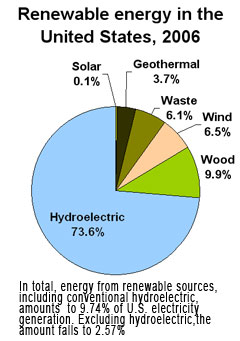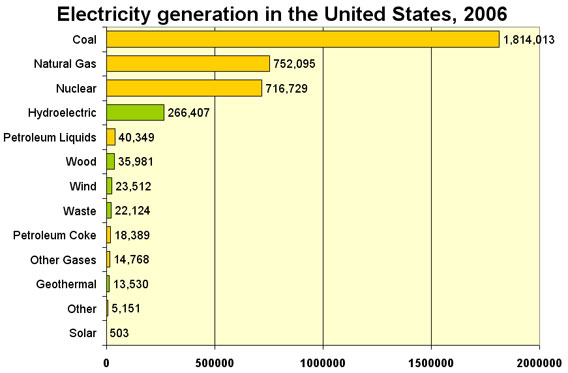Wind energy speculation jumps in Texas, but Exxon on sidelines
Wind energy speculation jumps in Texas, but Exxon on sidelines
mongabay.com
March 12, 2007
While speculative energy ventures are nothing new in Texas, today companies are taking risky gambles in wind power argues an article that appears in today’s issue of The Wall Street Journal (WSJ).
The WSJ reports that energy firms are investing hundreds of millions of dollars in some of the most remote — and windy — parts of Texas, but notes that the investments will only pay off with government subsidies.
“Generating power from wind isn’t profitable without government tax breaks, which in the past have been offered and taken away,” writes Jeffrey Ball, author of the article. “The big proposed projects in Texas, like those elsewhere in the country, are dependent on regulators approving transmission lines to connect remote and windy regions to major power markets. If the new lines aren’t built, the projects are doomed. Such uncertainty has dashed hopes for fossil-fuel alternatives before, creating a boom-and-bust cycle not unlike the one that typifies the oil industry itself

Chart showing renewable energy production in the United States for 2006. In total, energy from renewable sources, including conventional hydroelectric, amounts to 9.74% of U.S. electricity generation. Excluding hydroelectric, the amount falls to 2.57%. Figures from the Department of Energy’s (DOE) Energy Information Administration (EIA). Chart created by Rhett A. Butler, mongabay.com. |
“Energy companies investing in wind power are expecting governments to toughen rules relating to traditional energy sources, part of long-term efforts to reduce global-warming emissions and reliance on Middle East oil,” he continues. “As a result, they’re hoping renewable energy will become a profitable niche, not merely one that allows them to burnish their green credentials.”
The resulting wind rush could prove to be a bonanza for ranchers owning land is breezy areas, like the Texas Panhandle, says Ball.
“Local landowners who grew up cursing the wind can’t believe their new luck,” he writes.
While citing figures from the Lawrence Berkeley National Laboratory which show that capital spending on new wind projects in the U.S. rose from $420 million in 2004 to $3.65 billion in 2006, Ball notes that wind power provides less than 1 percent of U.S. energy needs.
Among conventional energy firms, Royal Dutch Shell Group and BP have shown a lot of interest in wind power, while Exxon has not, reportedly saying “it doesn’t want to get into a business that depends on subsidies,” seemingly forgetting that the oil and gas industry is heavily subsidized itself.
CITATION: “The Texas Wind Powers A Big Energy Gamble” by Jeffrey Ball. Appeared in The Wall Street Journal on March 13, 2007.

Chart showing total energy production in the United States for 2006. Reneable energy sources are in green. Figures from the Department of Energy’s (DOE) Energy Information Administration (EIA). Chart created by Rhett A. Butler, mongabay.com. |
Related articles
Balloon technology could cut cost of solar energy 90% by 2010
With high energy prices and mounting concerns over human-induced climate change, there is intense interest in renewable energy, especially solar, which produces no pollution and is readily available in the form of sunlight. In recent years, however, the solar energy market has been hampered by supply shortages of refined silicon, the critical resource needed for solar cell fabrication. Further, because solar installations traditionally require a large surface area to capture as much sunlight as possible, solar arrays often take up real estate, occupying land used agricultural production and other purposes. Without government subsidies, solar is not presently viable in many areas.
Geothermal energy could cut U.S. oil demand
Geothermal energy could eventually power some 25 million homes across the United States at a cost of $40 million per year according to a Department of Energy sponsored study released Monday. Lead by Jefferson Tester, a professor at MIT and lead author, the report argues that unlocking the heat stored in Earth’s crust could improve American energy security while reducing emissions greenhouse gases blamed for global warming.
Air pollution may reduce wind power, rainfall
Aerosolized particles and other pollution produced from vehicle exhaust may reduce wind speeds near Earth’s surface, resulting in less wind for power generation as well as reduced precipitation, according to a study published in the December 27th online edition of Geophysical Research Letters by researchers at Stanford University and NASA
Renewable sources could power 25% of U.S. energy needs by 2025
Renewable energy sources could supply one quarter of America’s electricity and motor vehicle fuel needs by 2025 according to a new study from RAND, a nonprofit research organization. Currently six percent is energy used in the United Stats comes from renewable sources like solar, biomass, hydroelectric, tidal, wind, and geothermal.
Bacteria can generate renewable energy from pollution, help fight global warming
Currently, most energy production generates carbon dioxide, a potent greenhouse gas that contributes to global warming and local pollution. At the same time that carbon dioxide concentrations are rising in the atmosphere, fueling higher temperatures, burgeoning population growth of humans and livestock is producing ever-increasing amounts of organic pollution and waste. Now researchers at the Center for Biotechnology at the Biodesign Institute of Arizona State University are working on a way to solve both problems using bacteria to convert organic wastes into a source of electricity. Bruce Rittmann, Director of the Center for Environmental Biotechnology at the Biodesign Institute, and his team of researchers are developing microbial fuel cells (MFC) that can oxidize organic pollutants and create electricity from pollution.
Google worried about global warming?
Google said it plans to build a solar-powered electricity system at its Silicon Valley headquarters that be the largest solar installation on any corporate campus in the United States.














